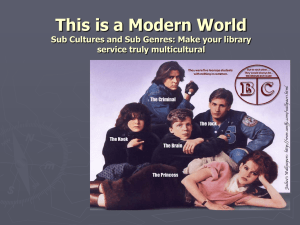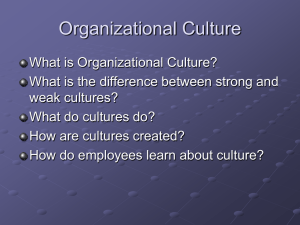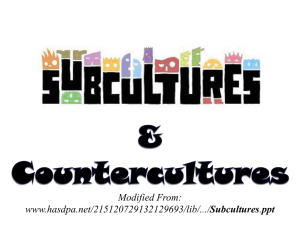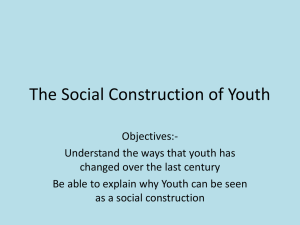Mediating Subcultural Capital
advertisement
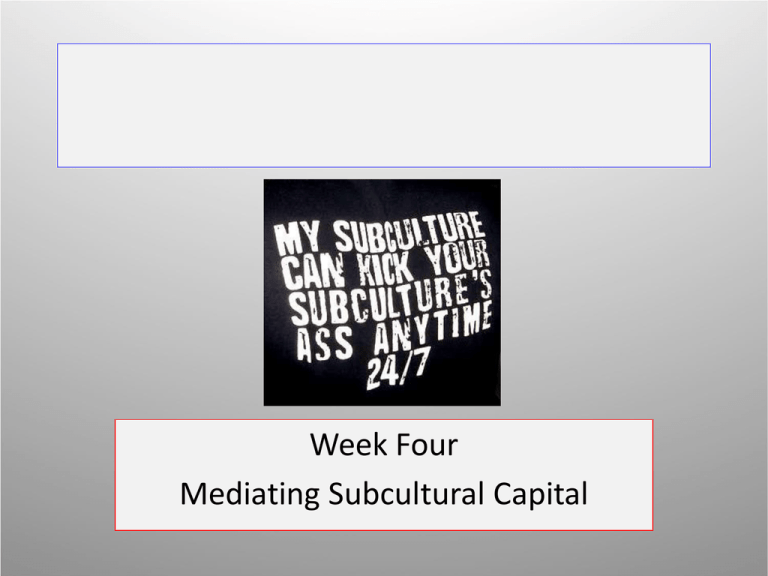
Week Four Mediating Subcultural Capital Session Topics Youth Subcultures Subculture and Style Sarah Thornton and ‘Subcultural Capital’ Clubbing and the Media Youth Subcultures One of the major strands of research on youth in Britain involves the study of youth subcultures. Research on youth subcultures was pioneered in the 1970s by a group of sociologists in Birmingham who adopted a neo-Marxist approach. Their work saw class as a crucial factor influencing the development of youth culture. In the 1970s and 1980s the Centre for Cultural Studies (CCCS) at Birmingham University started to study youth subcultures which had developed from the 1950s onwards. The work of the CCCS provides the starting point subsequent research on youth culture. Even quite recent can be seen as a development of, or reaction against, the views of the CCCS. Youth Subcultures In Resistance through Rituals (1976), John Clarke, Stuart Hall, Tony Jefferson and Brian Roberts outline a theoretical approach to the study of youth cultures. They do so within a broadly Marxist framework, arguing that material circumstances impose limits on the sorts of cultures people can develop. These cultures are seen as being closely related to class divisions. However, rather than simply reproducing class-based cultures, subcultures are seen as a creative response by some young people to the class situation they finds themselves in. Youth Subcultures According to Clarke, et al.: “the ‘culture’ of a group or class is the distinctive ‘way of life’ of the group or class, the meanings, values and ideas embodied in institutions, in social relations, in systems of beliefs, in mores and customs, in the uses of objects and material life. Culture is the distinctive shape in which this material and social organisation of life expresses itself. A culture includes the maps of meaning which makes things intelligible to its members.” (1976: 10-11) Youth Subcultures Individuals are born into particular cultures and these tend to shape the way in which they see the world; their ‘maps of meaning’, as Clarke et al. term it. However, these maps of meaning and their associated cultures change as history unfolds and as members of social groups actively create cultures and innovate. But groups cannot just create new cultures at will. Cultures always relate to experiences and sets of material circumstances and are always partly shaped by pre-existing cultures. Youth Subcultures Furthermore, cultures exist in hierarchical relationship to one another. The culture of dominant groups is always likely to be more powerful than the cultures of less powerful groups. Clarke et al. deny that a whole society’s culture will ever be dominated by one ruling-class ideology. They draw on the theories of the Italian Marxist, Antonio Gramsci. Gramsci argued that in order to achieve political and ideological domination – which he called ‘hegemony’ – powerful classes always had to make compromises with less powerful classes. Dominant ideology can always be opposed and hegemony is never complete. Subordinate cultures will generally try to win space, to make room for their own distinctive lifestyles, values and institutions away from the influence of more powerful classes. Youth Subcultures To Clarke et al., youth subcultures often represent creative attempts to try to maintain or win autonomy or space from dominant cultures. They win “cultural space in the neighbourhood and institutions, real time for leisure and recreation, actual room on the street-corner”. They are partly shaped by the parent culture of the class from which they originate (for example, working class or middle class), but they are distinct from it. Youth cultures create their own distinctive style: for example, by choosing a style of dress and listening to a particular style of music. The styles adopted by individual cultures represent an attempt to “solve, but in an imaginary way, problems which at the concrete material level remains unresolved”. Youth Subcultures There tends to be a homology between the styles chosen and the values and ideas being expressed. That is, objects and styles are chosen by groups which fit the meanings they are expressing. Elements of style might therefore reflect class differences. Youth subcultures emphasise the importance of authenticity. It is seen as paramount that a subculture is genuine and not a media creation. Once the media start to portray a youth subculture, it becomes distorted and influenced by ruling-class ideology. Subculture and Style Dick Hebdige was one of the contributors to Resistance through Rituals. He then went on to develop his own approach to the understanding of subcultures in Subculture: the meaning of style (1979). Like the CCCS, Hebdige saw class as key to understanding subcultures, but he also drew extensively on other theoretical approaches. In particular, he used semiotics (see Week 3) in order to try to understand the meaning of a number of post-war British youth subcultures. The meaning of signs is based on contrasts with other signs: they are defined in terms of their difference compared to other things. To Hebdige, it was possible to understand the meaning of the quiff of the Teddy boy, the safety pins of punks or the music of the mods, using semiotics. Subculture and Style Each youth subculture developed its own style and each took everyday objects and transformed their meaning. For example, Teddy Boys (‘Teds’) in the 1950s transformed the meaning of Edwardian suits and pointed boots – originally worn by ‘upper-class dandies’ – hoping that some of the status of the group would rub off on them. In the 1970s, Punks transformed the meaning of safety pins and ripped jeans to detach symbols from their conventional meanings, while disappointments with that stemmed from high unemployment began to be conveyed in the clothes and subcultural style of Rastafarians. British Rastafarians expressed their alienation from British culture by adopting simple clothes with and African sensibility. Army surplus stores provided garments able to express ‘sinister guerilla chic’. http://eddyteddy.files.wordpress.com/2010/01/tedsaaventine.jpg http://www.toptenz.net/wp-content/uploads/2009/04/punks-271x300.jpg See also: www.toptenz.net/top-10-youth-subcultures.php http://www.ukrockfestivals.com/Eleph-83-Zephaniah2-350.jpg Subculture and Style Each subculture defines itself in opposition to ‘mainstream’ culture. It is a self-conscious repudiation of the widely shared lifestyle and taste of the wider population. For example, subcultures reject pop music and conventional clothing. Each subculture is also spectacular: it creates a spectacle and is intended to get noticed. These styles signified membership of particular subcultures and became gestures of defiance against society. Subculture and Style According to Hebdige: “The subcultures with which we have been dealing share a common feature apart from the fact they are all predominantly working-class. They are... cultures of conspicuous consumption – even when, as with the skinheads and the punks, certain types of consumption are conspicuously refused – and it is through the distinctive rituals of consumption, through style, that the subculture at once reveals its ‘secret’ identity and communicates its forbidden meanings.” (1979: 102-103) Subculture and Style The work of the CCCS (including Hebdige) was important in two ways: - It developed a neo-Marxist approach to youth subcultures; - It encouraged sociologists to take youth culture seriously. Even those who are highly critical of this work often use it as a starting point. Subculture and Style However, the neo-Marxist elements of their approach have fallen out of fashion. Some have seen these theories as exaggerating the importance of class at the expense of other social divisions such as gender and ethnicity. The CCCS assumed that the subcultures they discussed were almost exclusively working class. They did not carry out extensive primary research to identify the economic status of their members. Subculture and Style The CCCS placed little emphasis on ethnicity and locality as influences on the formation of subcultures. For example, researchers in the USA have examined the crucial role of ‘race’ and ethnicity in the development of subcultures based on hip-hop and other African-American musical styles. Some youth culture theorists, like Andy Bennett and Keith Kahn-Harris, not only deny that class plays an important part in subcultures, but even question whether well-defined subcultures even really exist. http://asianconnection71.com/AfricaFistZm.jpg http://nikeshoponline.com/images/airmax/rare%20Air%20Max%2095/air-max-95-rasta.jpg Subcultural Capital One of the most influential studies of youth culture in this area of research since the CCCS is Sarah Thornton’s Club Cultures (1995). Thornton carried out an ethnographic study of dance music, clubs and raves in the early-1990s. She acknowledges that she was influenced by the Birmingham research but points out that her work differs in a number of ways. Subcultural Capital Thornton does not see club cultures as primarily oppositional to dominant culture. She does not emphasize the importance of class in shaping club culture. Clubbing is not characterized by close-knit groups who hang around much of the time united by their common culture. Rather, clubbers come together at specific times at specific dance events. Club cultures are therefore more a scene which people take part in on a part-time basis rather than a complete lifestyle. Thornton does not draw upon the theories of Gramsci in developing her ideas, but instead gets most of her inspiration from the work of Pierre Bourdieu. Subcultural Capital Bourdieu was influenced by Marxist theory and argued that there are different forms of ‘capital’ – economic capital, social capital and cultural capital – which can be used to obtain wealth status or power in society. Thornton uses the term ‘subcultural capital’ to show how inequality within club culture itself is maintained. While subcultural capital can sometimes be used to gain economic capital – for example, if you become a DJ in club culture – its main value is in providing status to the clubber. Thornton argues that the most important aspect of club culture is the way it is used by the young to differentiate themselves. Thronton sees dance club cultures as taste cultures in which the demonstration of good taste, or hipness, gets you social approval and recognition. Subcultural Capital “Subcultural capital conveys status on its owner in the eyes of the relevant beholder… Just as books and paintings display cultural capital in the home, so subcultural capital is objectified in the form of fashionable haircuts and wellassembled record collections (full of wellchosen, limited edition ‘white label’ twelve inches and the like). Just as cultural capital is personified in good manners and urbane conversation, so subcultural capital is embodied in the form of being ‘in the know’, using (but not over-using) current slang and looking as if you were born to perform the latest dance styles.” (1995: 10-11) Clubbing and the Media In electronic or ‘underground’ dance culture (EDM/UDM), keeping up with latest trends to maintain subcultural capital is very important. Scene members must guard against continuing to enjoy music which is too popular or which has become too mainstream to provide subcultural capital. By the middle of 1989, media coverage had made acid house culture too popular to be ‘underground’. Acid house fans came to be known as followers of media trends, rather than trend-setters. Since then, we have seen similar changes when the popular rave form jungle transformed into the more exclusive, underground style of drum ‘n’ bass; when the ‘feminine’ UK garage into the more maleoriented grime and dubstep; when mainstream, club-oriented house turned into the more localised and scene-centred progressive, minimal, etc. Clubbing and the Media Thornton argues that EDM cultures cannot be seen as a form of rebellion against ruling-class dominance, as CCCS theorists claimed for the subcultures they studied. Club culture also fails to challenge dominant power relations in its attitude to the media. Although hardcore clubbers reject the musical styles that get the most airplay, subcultural capital is still a product of the media. Local micro-media such as flyers are used to bring clubbers together, and niche media, such as parts of the music press, are key arbiters of ‘hipness’. Without the media, there would be no way of communicating the degrees of subcultural capital associated with different clubs, DJs or musical styles. Therefore, despite the apparent rejection of the media by the hardcore, the media are integral to the production of club cultures. The tastes of the hardcore are as much a product of the media as the mainstream tastes of those they look down on. Clubbing and the Media Comparing his findings on goths with the claims of the CCCS, Hodkinson (2004) found major differences: - There was more fluidity in participation in the goth scene than in the subcultures of the 1970s. - Contrary to the CCCS approach, there was no clear relationship between Goths and a particular class – they came from a variety of class backgrounds. However, Hodkinson also found no evidence that goth culture supported particular middle-class values. - The development of the style was closely linked with its promotion through the mass media. Goths did not see this as undermining the authenticity of the goth scene. http://nickgilmartin.files.wordpress.com/2009/07/acid-house-party.jpg Clubbing and the Media According to Hodkinson: “…the extent of the links with the media and commerce, and the lack of any absolute meaning, function or class identity simplified by the style would invalidate the use of the structuralist slant placed on the notion of subculture by the Birmingham theorists (the CCCS).” (2004: 139) http://jacketupload.macmillanusa.com/jackets/high_res/jpgs/9781859736050.jpg Clubbing and the Media Hodkinson found that despite all the above points, Goths had considerable subcultural substance. By this he means that they retained crucial features of subcultures, including: “…consistent distinctiveness in group values and tastes, a strong sense of shared identity, practical commitments among participants, and a significant degree of autonomy in the facilitation and operation of the group”. (2004: 139) Clubbing and the Media Goths are consistently distinctive because, despite individual variations, they and others can easily distinguish members of the subculture from nonmembers. Members had a clear sense of identity as Goths. Respondents also expressed a sense of shared identity with other Goths who lived elsewhere and they did not know personally. Therefore, Goths had a trans-local sense of identity; that is, a sense of identity that transcended local boundaries. There was a clear sense of insiders and outsiders, which is typical of subcultures. References Clarke, J., Hall, S., Jefferson, T., and Roberts, B. (1976) ‘Subcultures, Cultures and Class’, in Resistance Through Rituals: Youth Subcultures in Post-War Britain, Hall, S. and Jefferson, T. (eds.), London: Hutchinson. Hebdige, D. (1979) Subculture: the meaning of style, London: Routledge. Hodkinson, P. (2004) ‘The Goth Scene and (Sub)cultural Substance’, in After Subculture: Critical Studies in Contemporary Youth Culture, Bennett, A. and Kahn-Harris, K. (eds.), Basingstoke: Palgrave Macmillan. Thornton, S. (1995) Club Cultures: music, media and subcultural capital, Cambridge: Polity.
